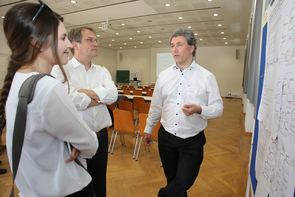Last week a new Macroeconomic Modelling and Model Comparison Network (MMCN) was launched with a research conference at Goethe University Frankfurt. Economists from the IMF, the Fed, the ECB, and other central banks presented and compared policy models along with academics from Chicago, Penn, Amsterdam and elsewhere. Such collaboration and exchange will define the new network. Judging from the first conference, it got off to a good start.
The conference led off with a critical review of macroeconomic models used for policy from a finance perspective by Winston Dou, Andrew Lo, Ameya Muley, and Harald Uhlig. The paper surveyed monetary models used at central banks, and it pointed out problems with current models, especially linearized versions, suggesting newer solution, estimation, and evaluation methods. The paper also proposed research on a new generation of policy models incorporating the financial sector, the government balance sheet, unconventional monetary policy, heterogeneity, reallocation, redistribution effects, nonlinear risk-premiums, time-varying uncertainty, and imperfect product markets.
So there is much work to do, and indeed the conference showed that work had begun. Doug Laxton of the IMF presented research on new models with credit and financial constraints. Roberto Motto examined the ECB’s approach to unconventional monetary policy. John Roberts examined the implications of recent lower estimates of the equilibrium interest rates using both the ECB’s model and the Fed’s main model. Maik Wolters showed that the evidence was weak that the equilibrium real rate has fallen. There were also parallel sessions on fiscal policy, macro-prudential policy, and  international monetary policy along with poster sessions with 20 different presentations with a range of fresh new ideas on models used to find good monetary policy rules.
international monetary policy along with poster sessions with 20 different presentations with a range of fresh new ideas on models used to find good monetary policy rules.
The network will be operated under the auspices of Centre for Economic Policy Research in London which is directed by Richard Baldwin. The network, which welcomes researchers interested in policy and model comparisons, is one part of a larger project called the Macroeconomic Model Comparison Initiative (MMCI) organized by Michael Binder, Volker Wieland, and me. That initiative includes the Macroeconomic Model Data Base, which already has 82 models that have been developed by researchers at central banks, international institutions, and universities. Key activities of the initiative are comparing solution methods for speed and accuracy, performing robustness studies of policy evaluations, and providing more powerful and user-friendly tools for modelers.
An essential prerequisite of the initiative is that the models be put forth in transparent ways that make replication easy. Obviously quantitative macroeconomic models play an important role in informing policy makers about the consequences of monetary and fiscal policies, and an objective of the new initiative is to improve the interface between researchers and policy makers, and thus make better use of economics to improve policy.



